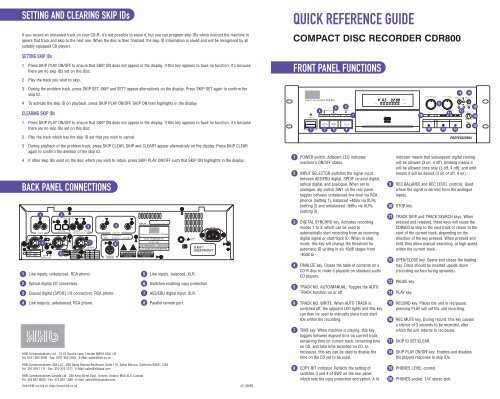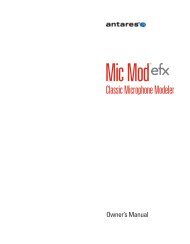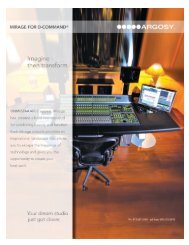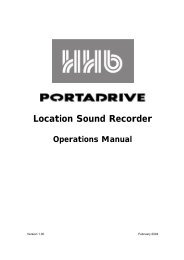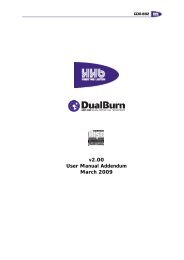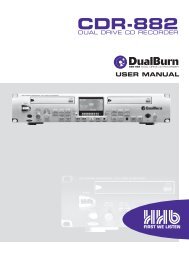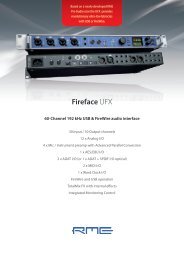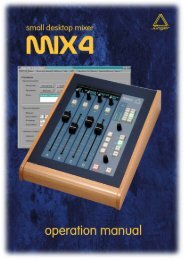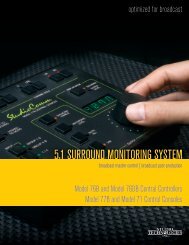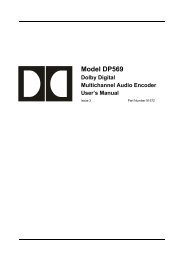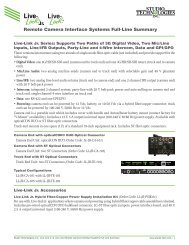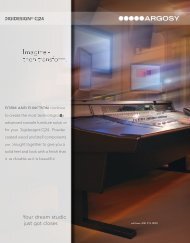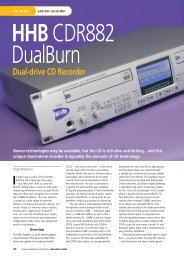CLEARING SKIP IDs - HHb
CLEARING SKIP IDs - HHb
CLEARING SKIP IDs - HHb
Create successful ePaper yourself
Turn your PDF publications into a flip-book with our unique Google optimized e-Paper software.
SETTING AND <strong>CLEARING</strong> <strong>SKIP</strong> <strong>IDs</strong><br />
If you record an unwanted track on your CD-R, it's not possible to erase it, but you can program skip <strong>IDs</strong> which instruct the machine to<br />
ignore that track and skip to the next one. When the disc is then finalized, the skip ID information is saved and will be recognised by all<br />
suitably equipped CD players.<br />
SETTING <strong>SKIP</strong> <strong>IDs</strong><br />
1 Press <strong>SKIP</strong> PLAY ON/OFF to ensure that <strong>SKIP</strong> ON does not appear in the display. If this key appears to have no function, it's because<br />
there are no skip <strong>IDs</strong> set on this disc.<br />
2 Play the track you wish to skip.<br />
3 During the problem track, press <strong>SKIP</strong> SET. <strong>SKIP</strong> and SET? appear alternatively on the display. Press <strong>SKIP</strong> SET again to confirm the<br />
skip ID.<br />
QUICK REFERENCE GUIDE<br />
COMPACT DISC RECORDER CDR800<br />
FRONT PANEL FUNCTIONS<br />
15 16<br />
4 To activate the skip ID on playback, press <strong>SKIP</strong> PLAY ON/OFF. <strong>SKIP</strong> ON then highlights in the display.<br />
<strong>CLEARING</strong> <strong>SKIP</strong> <strong>IDs</strong><br />
6<br />
8<br />
5<br />
7<br />
10<br />
9<br />
11<br />
17<br />
18<br />
19<br />
1 Press <strong>SKIP</strong> PLAY ON/OFF to ensure that <strong>SKIP</strong> ON does not appear in the display. If this key appears to have no function, it's because<br />
there are no skip <strong>IDs</strong> set on this disc.<br />
1 2 3 4<br />
12 13 14<br />
20<br />
2 Play the track which has the skip ID set that you wish to cancel.<br />
3 During playback of the problem track, press <strong>SKIP</strong> CLEAR. <strong>SKIP</strong> and CLEAR? appear alternatively on the display. Press <strong>SKIP</strong> CLEAR<br />
again to confirm the deletion of the skip ID.<br />
4 If other skip <strong>IDs</strong> exist on the disc which you wish to retain, press <strong>SKIP</strong> PLAY ON/OFF such that <strong>SKIP</strong> ON highlights in the display.<br />
BACK PANEL CONNECTIONS<br />
1<br />
5 7<br />
1 Line inputs, unbalanced, RCA phono.<br />
2 Optical digital I/O connectors.<br />
2<br />
6<br />
3 4<br />
3 Coaxial digital (SPDIF) I/O connectors, RCA phono.<br />
8<br />
5 Line inputs, balanced, XLR.<br />
6 Switches enabling copy protection.<br />
7 AES/EBU digital input, XLR.<br />
1 POWER switch. Adjacent LED indicates<br />
machine's ON/OFF status.<br />
2 INPUT SELECTOR switches the signal input<br />
between AES/EBU digital, SPDIF co-axial digital,<br />
optical digital, and analogue. When set to<br />
analogue, dip switch SW1 on the rear panel<br />
toggles between unbalanced line level via RCA<br />
phonos (setting 1), balanced +4dBu via XLRs<br />
(setting 2) and unbalanced –8dBu via XLRs<br />
(setting 3).<br />
3 DIGITAL SYNCHRO key. Activates recording<br />
modes 1 to 3, which can be used to<br />
automatically start recording from an incoming<br />
digital signal or start/track ID. When in stop<br />
mode, this key will change the threshold for<br />
automatic ID writing in six 10dB stages from<br />
-40dB to - .<br />
4 FINALIZE key. Closes the table of contents on a<br />
CD-R disc to make it playable on standard audio<br />
CD players.<br />
5 TRACK NO. AUTO/MANUAL. Toggles the AUTO<br />
TRACK function on or off.<br />
indicator means that subsequent digital cloning<br />
will be allowed (3 on, 4 off); blinking means it<br />
will be allowed once only (3 off, 4 off); and unlit<br />
means it will be denied (3 on or off, 4 on).<br />
9 REC BALANCE and REC LEVEL controls. Used<br />
where the signal is derived from the analogue<br />
inputs.<br />
10<br />
11<br />
12<br />
13<br />
14<br />
STOP key.<br />
TRACK <strong>SKIP</strong> and TRACK SEARCH keys. When<br />
pressed and released, these keys will cause the<br />
CDR800 to skip to the next track or return to the<br />
start of the current track, depending on the<br />
direction of the key pressed. When pressed and<br />
held, they allow manual searching, at high speed,<br />
within the current track.<br />
OPEN/CLOSE key. Opens and closes the loading<br />
tray. Discs should be inserted upside down<br />
(recording surface facing upwards).<br />
PAUSE key.<br />
PLAY key.<br />
4 Line outputs, unbalanced, RCA phono.<br />
HHB Communications Ltd · 73-75 Scrubs Lane, London NW10 6QU, UK<br />
Tel: 0181 962 5000 · Fax: 0181 962 5050 · E-Mail: sales@hhb.co.uk<br />
HHB Communications USA LLC · 626 Santa Monica Boulevard, Suite 110, Santa Monica, California 90401, USA<br />
Tel: 310 319 1111 · Fax: 310 319 1311 · E-Mail: sales@hhbusa.com<br />
HHB Communications Canada Ltd · 260 King Street East, Toronto, Ontario M5A 4L5, Canada<br />
Tel: 416 867 9000 · Fax: 416 867 1080 · E-mail: sales@hhbcanada.com<br />
Visit HHB on-line at: http://www.hhb.co.uk<br />
8 Parallel remote port.<br />
6 TRACK NO. WRITE. When AUTO TRACK is<br />
switched off, the adjacent LED lights and this key<br />
can then be used to manually place track start<br />
<strong>IDs</strong> within the recording.<br />
7 TIME key. When machine is playing, this key<br />
toggles between elapsed time on current track,<br />
remaining time on current track, remaining time<br />
on CD, and total time recorded on CD. In<br />
rec/pause, this key can be used to display the<br />
time on the CD yet to be used.<br />
15<br />
16<br />
17<br />
18<br />
RECORD key. Places the unit in rec/pause;<br />
pressing PLAY will set the unit recording.<br />
REC MUTE key. During record, this key causes<br />
a silence of 3 seconds to be recorded, after<br />
which the unit returns to rec/pause.<br />
<strong>SKIP</strong> ID SET/CLEAR.<br />
<strong>SKIP</strong> PLAY ON/OFF key. Enables and disables<br />
the players response to skip <strong>IDs</strong>.<br />
8 COPY BIT indicator. Reflects the setting of<br />
switches 3 and 4 of SW2 on the rear panel,<br />
which sets the copy protection encryption. A lit<br />
19<br />
20<br />
PHONES LEVEL control.<br />
PHONES socket. 1/4" stereo jack.<br />
v2. 09/98
OVERVIEW<br />
CONTROLLING TRACK START INFORMATION<br />
The CDR800 has five modes of operation for recording a CD. The mode you choose will depend on the format<br />
of the input signal, and the way you wish to control the CD’s track starts. Modes 1 to 3 are Digital Synchro<br />
modes, which trigger recording from the incoming audio signal or start/track ID information, thus ensuring a<br />
neat start. However, with the AES/EBU protocol, start/track <strong>IDs</strong> are not transferable.<br />
MODE 1: 1-Track Digital Synchro<br />
The CDR800 records one single track, and returns to record ready. Ideal for making compilation CDs.<br />
MODE 2: All-Track Digital Synchro<br />
Records incoming tracks in sequence, stopping automatically after the last track.<br />
MODE 3: ID-Sync Digital Synchro<br />
Creates new tracks according to start/track ID information in the incoming datastream. Ideal for making an<br />
identical digital clone. Remember that this only applies via the SPDIF co-axial and optical protocol.<br />
MODE 4: Manual Digital<br />
Recording is controlled by the ‘cassette deck’ style transport keys.<br />
MODE 5: Manual Analogue<br />
Analogue source recording, controlled by the transport keys, as well as the recording balance and level<br />
controls.<br />
NOTE: Exactly how these modes write track starts in your recording will depend on the setting of the<br />
AUTO TRACK function. See the following page of this quick start guide for details.<br />
HOW TO RECORD A CD<br />
NOTE: Insert a blank disc onto the CD tray with the label side down and the shiny recording surface facing<br />
upwards. This is contrary to normal audio CD players.<br />
MODES 1, 2 and 3 – Digital Synchro<br />
1 Use INPUT SELECTOR to set the digital input format: AES/EBU (display shows DIGITAL 1, <strong>IDs</strong> not transferable<br />
with this protocol), SPDIF (display shows DIGITAL 2), or optical (display shows DIGITAL 1 & 2).<br />
2 Ensure that your source player (the unit you are recording from) is not playing (ideally place it in<br />
play/pause). The CDR800 cannot enter DIGITAL SYNCHRO mode if the source machine is playing.<br />
3 Press DIGITAL SYNCHRO: once to engage Mode 1 (1-Track), twice to engage Mode 2 (All-Track) and three<br />
times to engage Mode 3 (ID-Sync).<br />
4 The word SYNC will appear in the display in red, after SETUP is displayed, and will flash to indicate that<br />
the CDR800 is waiting for audio.<br />
5 On receipt of audio, or a start/track ID, the CDR800 will start recording automatically. As this is SYNCHRO<br />
mode, recording will stop automatically. However, recording can of course be stopped at any time by<br />
pressing STOP. Note that if the digital input has a sampling rate of 48kHz, the CDR800 automatically<br />
converts this to 44.1kHz using the built-in sample rate converter.<br />
MODES 4 & 5 – Manual Digital / Manual Analogue<br />
1 Use INPUT SELECTOR to set the format of signal to be recorded: AES/EBU digital (display shows<br />
DIGITAL 1, <strong>IDs</strong> are not transferable with this protocol), SPDIF co-axial digital (display shows DIGITAL 2),<br />
optical digital (display shows DIGITAL 1 and DIGITAL 2), or analogue (display shows ANALOGUE).<br />
2 Press RECORD. The CDR800 will enter rec/pause mode, allowing you to monitor signal throughput, both<br />
audibly and visibly on the display meters.<br />
3 If you are recording an analogue signal (Mode 5) set the REC LEVEL so that the 0 indicator at the right of<br />
the display occasionally lights. The red OVER indicator must never light; this will result in distortion.<br />
4 At the appropriate moment, press PLAY to start the CDR800 recording. As this is manual mode, recording<br />
will continue until manually stopped.<br />
5 To stop recording, press REC MUTE. A four second silence will be recorded, after which the CDR800 will<br />
enter rec/pause. If you do not want to record this silence between tracks, simply press STOP or PAUSE.<br />
One of the most difficult aspects of CD Recording is controlling the placement of track starts, because once<br />
a recording is made it cannot be altered. Each of the five CDR800 modes work slightly differently in this<br />
regard, and are further influenced by the setting of the AUTO TRACK function. Again, only the SPDIF digital<br />
interface carries information about start/track <strong>IDs</strong>. Here is a breakdown of exactly how each mode behaves<br />
in either setting:<br />
MODE 1 - DIGITAL SYNCHRO 1-TRACK<br />
Recording starts on audio or start/track ID only • AUTO TRACK ON: Subsequent <strong>IDs</strong> cause the machine to<br />
go into rec/pause • AUTO TRACK OFF: Subsequent <strong>IDs</strong> are ignored • Silence of 10 seconds causes the<br />
machine to go into rec/pause • When audio starts again, machine does not start recording again<br />
MODE 2 - DIGITAL SYNCHRO ALL-TRACK<br />
Recording starts on audio or start/track ID only • AUTO TRACK ON: Subsequent <strong>IDs</strong> cause a new track start<br />
to be written • AUTO TRACK OFF: Subsequent <strong>IDs</strong> are ignored • Silence of 10 seconds causes the machine<br />
to go back into AL-SYNC and wait for next audio • When audio starts again, machine goes back into record<br />
with a new track<br />
MODE 3 - DIGITAL SYNCHRO ID-SYNC<br />
Recording starts on ID only, audio does not cause the machine to start recording • AUTO TRACK ON:<br />
Subsequent <strong>IDs</strong> cause a new track start to be written • AUTO TRACK OFF: Subsequent <strong>IDs</strong> are ignored •<br />
Silence of 10 seconds causes the machine to go back into ID-SYNC and wait for next audio • When audio<br />
starts again, machine does not go back into record • The next ID causes the machine to start recording again<br />
MODE 4 - MANUAL DIGITAL<br />
When in record pause mode, pressing PLAY activates record • Mode 4 does not enable track starts to be<br />
triggered by incoming audio • AUTO TRACK ON: Subsequent <strong>IDs</strong> will cause a new track start • AUTO TRACK<br />
OFF: <strong>IDs</strong> are ignored • Silence of 30 seconds causes machine to go into rec/pause<br />
MODE 5 - MANUAL ANALOGUE<br />
Recording starts with new track on pressing of play button to activate record • AUTO TRACK ON: Audio<br />
levels do not cause a new track start to be written first time, thereafter they do • AUTO TRACK OFF: Audio<br />
levels do not cause a new track ever<br />
FINALIZING CDs FOR PLAYBACK ON STANDARD CD PLAYERS<br />
In order for a CD-R disc to be playable on audio CD players, it has to be closed to the standard CD audio<br />
format. This process is known as finalization. Note that once a disc has been finalized, it cannot be recorded<br />
on again.<br />
1 Insert the disc that you want to finalize.<br />
2 Press FINALIZE.<br />
3 After a few seconds, you will see the time that the finalization process will take (approximately four<br />
minutes) appear on the display.<br />
4 If you're sure about finalizing the disc, press PAUSE.<br />
5 The display counts down to indicate the progress of finalization. During this time, all the CDR800's<br />
functions are suspended.<br />
HHB CDR800 Compact Disc Recorder


